The euro (ISO 4217 code: EUR, symbol: €) is the official currency of the institutions of the European Union and the official currency of the 20 member states that are part of the Eurozone. These states are as follows:
- Austria.
- Belgium.
- Croatia.
- Cyprus.
- Estonia.
- Finland.
- France.
- Germany.
- Greece.
- Ireland.
- Italy.
- Latvia.
- Lithuania.
- Luxembourg.
- Malt.
- Netherlands.
- Portugal.
- Slovakia.
- Slovenia.
- Spain.
Croatia also from January 2023
Compare rates at 80 currency stores in 34 cities
As from January 2023, Croatia has become the 20th country in the Eurozone, definitely abandoning the kuna for the euro. The fixed exchange rate of the kuna with respect to the euro is definitively set at 7.53450 kuna per euro.
The currency of other European states
In addition to these countries, the Euro is used as the official currency in Andorra, Vatican City, Monaco and San Marino, by virtue of the agreements made with the European Union for the use of the Euro as currency.
And from other overseas territories
The euro is also the official currency of the two outermost autonomous regions of Portugal, Azores and Madeira. And also of the departments of French Guiana, Guadeloupe, Mayotte and Réunion, Martinique, and other French overseas territories, despite being outside the geographical limits of Europe. The European Central Bank (ECB), based in the German city of Frankfurt, is the only EU body that has the exclusive right to authorize the issuance of euro banknotes. The minting of coins, on the other hand, is optional for the member states, although the amount must be previously authorized by the ECB.
Euro history
Monetary union was one of the objectives set out in the Treaty of the European Union, which entered into force in 1993. The idea was to create a single currency that would be introduced gradually and that would be adopted by the EU countries that met the necessary conditions. The name euro was coined in 1995, replacing the first denomination of the European Currency Unit (ECU). The European Commission designed the euro symbol (€) inspired by the letter epsilon (ε) of the Greek alphabet and as a reference to the initial “E” of the word Europe.
Euro date
Compare rates at 80 currency stores in 34 cities
The date set for putting the single currency into circulation was January 1, 2002. In principle, only twelve states adopted the new currency: Germany, Austria, Belgium, Spain, Finland, France, Greece, Ireland, Italy, Luxembourg , the Netherlands and Portugal. That January 1, at dawn and overnight, historical currencies such as the German mark, the French franc, the Italian lira, the Portuguese escudo or the Spanish peseta disappeared to make way for the new single currency.
Latest additions to the Euro
In subsequent years, other states joined the eurozone: Slovenia (2007), Malta and Cyprus (2008), Slovakia (2009), Estonia (2011), Latvia (2014) and Lithuania (2015). And since January 2023, Croatia, has become the 20th country in the Eurozone. The adoption of the euro by the countries of the eurozone has been a positive boost for their economies. Among its main advantages, it is worth highlighting the elimination of the obstacles that the different exchange rates entailed in commercial transactions and greater flexibility in the financial markets. As a negative aspect, we must point out the loss of autonomy of the Eurozone states in terms of monetary policy, which in certain situations can be a disadvantage. A clear example is the case of Greece in 2009, a country that at the most serious moment of its economic crisis even considered abandoning the euro and returning to the old drachma.
Euro coins
Currently there are euro coins with the following values:
- Cent coins: 1, 2, 5, 10, 20 and 50 euro cents.
- Euro coins: €1 and €2.
Finland and the Netherlands stopped issuing 1 and 2 cent coins a few years ago. The reason is that its production cost is greater than its face value.
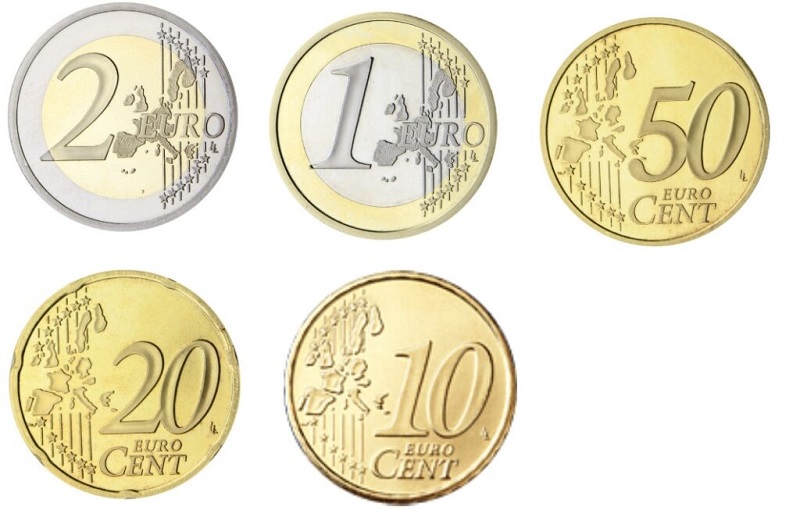
Common obverses of the Euro coins

Common obverses of the 1 2 and 5 cent euros coins
The reverse is called the “national side”, since each member state can introduce its own distinctive motifs and symbols on it. There are numerous variations, although since 2009 all of them must meet two conditions:
- The twelve European stars must appear completely surrounding the national design.
- It must appear from the year of issue and the name of the issuing Member State.
- The designs must not be modified, except in the event of a change in the Head of State to which they refer.
Euro banknotes
Euro banknotes are issued in denominations of €5, €10, €20, €50, €100, €200 and €500. The first issue was made in 2002, with the launch of the new currency. The second series, called the “Europa series”, is actually an updated design of the first. It began to be issued in 2013 and so far only new design banknotes of €5, €10, €20 and €50 have been issued, although the €100 and €200 are expected to be put into circulation in 2019. A new issue of the €500 note is not planned. The material of the euro banknotes is cotton fiber with a purity of 100%, very resistant and durable. The name of the currency is written in Cyrillic (EBPO) characters since Bulgaria joined the European Union in 2007, as well as Latin (EURO) and Greek (EYPΩ). The design theme of both series is “European Architectural Styles and Epochs”. All banknotes depict bridges, arches or gates in a different historical European style. A geographical representation of the European continent appears on the reverse of both series’ banknotes. The new series includes Malta and Cyprus, as well as the Canary Islands and some French overseas territories in the small boxes along the bottom edge, while the EU flag always appears on the obverse.
€5 banknote
The five euro banknote, gray in colour, is the smallest in the series (120 x 62 mm). It is dedicated to classical architecture, the bridges and facades that appear on it are not real monuments, but hypothetical examples of this architectural era.
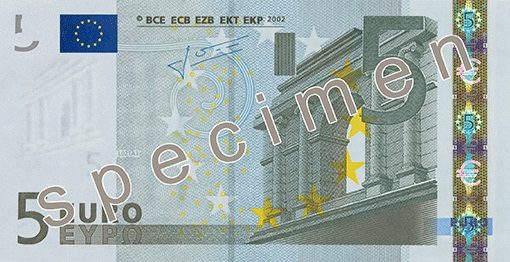
5 euro banknote
€10 banknote
The red 10 euro note is the second smallest note in the family, measuring 127 x 67 mm. The decoration focuses on Romanesque architecture (11th and 12th centuries).
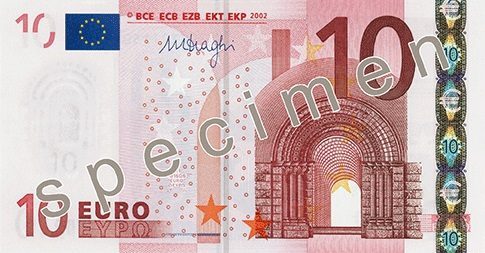
10 euro banknote
€20 banknote
European Gothic architecture, representative of the 13th and 14th centuries, is the protagonist of the blue twenty-euro banknotes, which have dimensions of 133 x 72 mm.
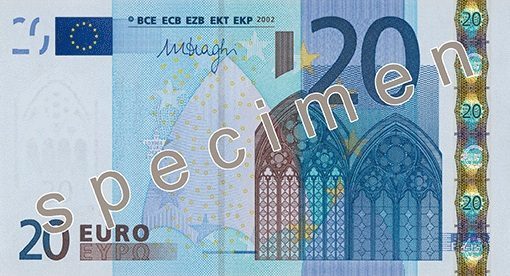
20 euro banknote
50 € banknote
The fifty euro note is orange-brown in color and measures 140 x 77 mm. The central theme is the architecture of the Renaissance period, between the fifteenth and sixteenth centuries. It is the most abundant ticket, as there are currently about 6.2 million of them in circulation.
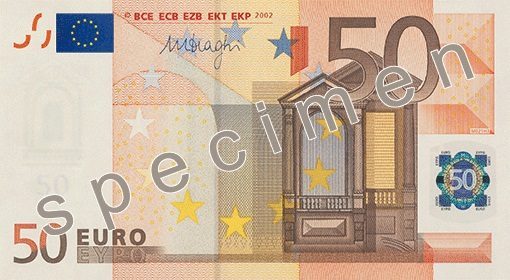
50 euro banknote
€100 banknote
Following the chronological order, the Renaissance is followed by the Baroque, the predominant architectural style in Europe in the 17th and 18th centuries, which is reflected in the green hundred-euro banknote.
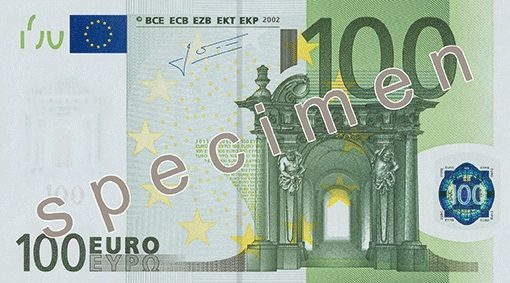
100 euro banknote
€200 banknote
The two hundred euro note is yellow in colour, measures 153 x 82 mm and represents the modernist architecture of the 19th century.
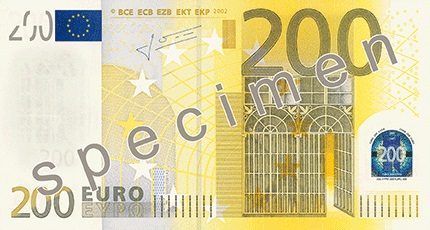
200 euro banknote
The purple 500-euro note is the largest in size and the one with the highest value that the European Central Bank has issued to date. Currently this banknote has ceased to be issued as a measure to combat certain crimes such as money laundering, drug trafficking and tax evasion (such high nominal values allow large amounts of money to be concentrated in a small volume of banknotes).
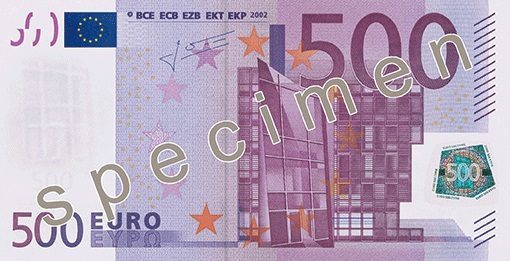
500 euro banknote
In fact, the very little traffic by ordinary people of these banknotes with such a high denomination, at the time made them colloquially known in Europe as “Bin Laden” because it was known that they existed but nobody ever had one in her hands.
Exchange euros for foreign currency
Cambiator offers you a daily comparison of euro exchange prices with respect to more than 55 currencies in Spanish currency suppliers (casas de cambio), banks and airports.
Buy foreign currency
If you want to buy foreign currency with your euros at today’s best rates, go to our “Buy currency” page, choose the currency you are looking for (we offer you 55 different ones) and follow the instructions.
Buy euros with foreign currency
If, on the other hand, you want to buy euros with foreign currency at the best rates, go to our “Buy euros” page, choose the currency you want to sell, the currency supplier where you can go and follow the instructions.
Other popular currencies
Best rate of the day (exchange euros to another currency)
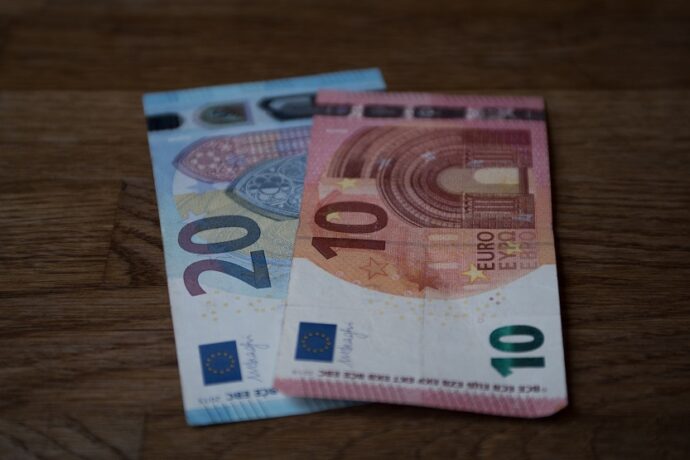
Sin comentarios